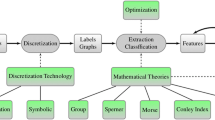Abstract
Visualization is the discipline in Computer Science dealing with the representation of data by computer generated images. “It transforms the symbolic into the geometric, enabling researchers to observe their simulations and computations,” [MD87, p. 2]. One major area visualizes vector fields. In applied mathematics, the study of gas dynamics, combustion and fluid flow leads to vector fields describing velocity, vorticity, and gradients of pressure, density and temperature. In engineering, computational fluid dynamics (CFD) and finite element analysis (FEA) produce large data sets. They are central for aeronautics, automotive design, construction, meteorology and geology. Methods based on topology have been used successfully because of their ability to concentrate information related to important properties. In fluid flows, important features like vortices and separation lines can be detected automatically by extracting topology [HH91]. Conventional approaches are based on piecewise linear or bilinear interpolation. Drawbacks of these methods are attacked in this thesis.
Access this chapter
Tax calculation will be finalised at checkout
Purchases are for personal use only
Preview
Unable to display preview. Download preview PDF.
Similar content being viewed by others
Literatur
J. L. Helman and L. Hesselink. Visualizing vector field topology in fluid flows. IEEE Computer Graphics and Applications, 11(3):36–46, 1991.
B. H. McCormick and T. A. DeFanti. Visualization in scientific computing. Computer Graphics, 21(6), 1987.
G. M. Nielson. A method for interpolating scattered data based upon a minimum norm network. Mathematics of Computation, 40:253–271, 1983.
G. Scheuermann and H. Hagen. A data dependent triangulation for vector fields. In Computer Graphics International 1998, pages 96–102, 1998.
G. Scheuermann, H. Hagen, H. Krüger, M. Menzel, and A. P. Rockwood. Visualization of higher order singularities in vector fields. In R. Yagel and H. Hagen, editors, IEEE Visualization ’97, pages 67–74, Los Alamitos, CA, 1997.
G. Scheuermann, H. Krüger, M. Menzel, and A. R Rockwood. Visualizing nonlinear vector field topology. IEEE Transactions on Visualization and Computer Graphics, 4(2): 109–116, 1998.
G. Scheuermann, X. Tricoche, and H. Hagen. C1-interpolation for vector field topology visualization. In D. A. Ebert, M. Gross, and B. Hamann, editors, IEEE Visualization ’99, pages 271–278, San Francisco, CA, 1999.
Author information
Authors and Affiliations
Editor information
Editors and Affiliations
Rights and permissions
Copyright information
© 2000 B. G. Teubner GmbH, Stuttgart/Leipzig/Wiesbaden
About this chapter
Cite this chapter
Scheuermann, G. (2000). Topological Vector Field Visualization with Clifford Algebra. In: Fiedler, H., et al. Ausgezeichnete Informatikdissertationen 1999. GI-Dissertationspreis. Vieweg+Teubner Verlag. https://doi.org/10.1007/978-3-322-84823-9_20
Download citation
DOI: https://doi.org/10.1007/978-3-322-84823-9_20
Publisher Name: Vieweg+Teubner Verlag
Print ISBN: 978-3-519-02650-1
Online ISBN: 978-3-322-84823-9
eBook Packages: Springer Book Archive




